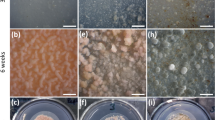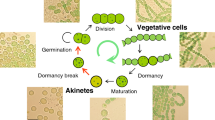Abstract
Three isolates of heterocystous cyanobacteria, belonging to the genera Anabaena and Nostoc, gathered from Iranian terrestrial and aquatic ecosystems exhibited considerable growth promotion effect on several vegetables and herbaceous plants. To study the ability of these three isolates to produce auxins, three endogenous auxins, including indole-3-acetic acid (IAA), and two of its main homologues, indole-3-propionic acid and indole-3-butyric acid, were extracted and analyzed with high-performance liquid chromatography equipped with diode array detector and fluorescence detector, and the results were further confirmed with liquid chromatography–tandem mass spectrometry (LC–MS/MS) in the negative-ion mode. The dominant auxin observed in all isolates was indole-3-butyric acid (IBA) in the range of 140.10–2146.96 ng g−1 fresh weight (FW), and only small amounts of IAA (2.19–9.93 ng g−1 FW) were detected. The predominance of IBA in these strains is reported for the first time which is different from the previously reported auxin profiles in microalgae and algae with the predominance of IAA.





Similar content being viewed by others
References
Ahmed M, Stal LJ, Hasnain S (2010) Production of indole-3-acetic acid by the cyanobacterium Arthrospira platensis strain MMG-9. Microbiol Biotechnol 20:1259–1265
Bertoni G (2011) Indolebutyric acid—derived auxin and plant development. Plant Cell 23:845
Blazich F (1988) Chemicals and formulations used to promote adventitious rooting. In: Davis TD, Haissig BE, Sankhla N (eds) Adventitious root formation in cuttings. Dioscorides, Portland, pp 132–149
Bocchi S, Malgioglio A (2010) Azolla-Anabaena as a biofertilizer for rice paddy fields in the Po Valley, a temperate rice area in Northern Italy. Int J Agron 1–5. doi:10.1155/2010/152158
Davies PJ (2004) Plant hormones: their nature, occurrence and function. In: Davies PJ (ed) Plant hormones: biosynthesis, signal transduction, action, 3rd edn. Kluwer Academic Publishers, Dordrecht, pp 1–15
Epstein E, Chen KH, Cohen JD (1989) Identification of indole-3-butyric acid as an endogenous constituent of maize kernel and leaves. Plant Growth Regul 8:215–223
Gutierrez CK, Matsui Y, Lincoln DE, Lovell CR (2009) Production of the phytohormone indole-3-acetic acid by estuarine species of the genus Vibrio. Appl Environ Microbiol 75:2253–2258
Jäger K, Bartók T, Ördög V, Barnabás B (2010) Improvement of maize (Zea mays L.) anther culture responses by algae-derived natural substances. S Afr J Bot 76:511–516
Komárek J (2010) Modern taxonomic revision of planktic nostocacean cyanobacteria: a short review of genera. Hydrobiologia 639:231–243
Kulasooriaya SA, Roger PA, Barraquio WA, Watanabe I (1981) Epiphytic nitrogen fixation on deepwater rice. Soil Sci Plant Nutr 27:19–27
Lau S, Shao N, Bock R, Jürgens G, Smet ID (2009) Auxin signaling in algal lineages: fact or myth? Trends Plant Sci 14:182–188
Lijun H (2006) The auxin concentration in sixteen Chinese marine algae. Chin J Oceanol Limnol 24:329–332
Ludwig-Müller J (2000) Indole-3-butyric acid in plant growth and development. Plant Growth Regul 32:219–230
Ludwig-Müller J (2011) Auxin conjugates: their role for plant development and in the evolution of land plants. J Exp Bot 62:1757–1773
Ludwig-Müller J, Epstein E (1991) Occurrence and in vivo biosynthesis of indole-3-butyric acid in corn (Zea mays L.). Plant Physiol 97:765–770
Ludwig-Müller J, Epstein E (1992) Indole-3-acetic acid is converted to indole-3-butyric acid by seedlings of Zea mays L. In: Karssen CM, van Loon LC, Vreugdenhil D (eds) Progress in plant growth regulation. Kluwer Academic Publishers, Boston, pp 188–193
Ludwig-Müller J, Epstein E (1994) Indole-3-butyric acid in Arabidopsis thaliana. III. In vivo biosynthesis. Plant Growth Regul 14:7–14
Maqubela MP, Mnkeni PNS, Muchaonyerwa AP, D’Acqui LP, Pardo MT (2010) Effects of cyanobacteria strains selected for their bioconditioning and biofertilization potential on maize dry matter and soil nitrogen status in a South African soil. J Soil Sci Plant Nutr 56:552–559
Mazhar S, Hasnain S (2011) Screening of native plant growth promoting cyanobacteria and their impact on Triticumaestivum var. Uqab 2000 growth. Afr J Agric Res 6:3988–3993
Mazur H, Konop A, Synak R (2001) Indole-3-acetic acid in the culture medium of two axenic green microalgae. J Appl Phycol 13:35–42
Mishra U, Pabbi S (2004) Cyanobacteria: a potential biofertilizer for rice. Resonance 2004:6–10
Nordström AC, Jacobs FA, Eliasson L (1991) Effect of exogenous indole-3-acetic acid and indole-3-butyric acid on internal levels of the respective auxins and their conjugation with aspartic acid during adventitious root formation in pea cuttings. Plant Physiol 96:856–861
Pardo MT, López-Fando C, Almendros G, Herrero A (2009) Laboratory assessment of Nostoc 9v (Cyanobacteria) effects on N2 fixation and chemical fertility of degraded African soils. Commun Soil Sci Plant Anal 40:1295–1321
Ravi M, De Lata S, Azharuddin S, Paul SFD (2010) The beneficial effects of Spirulina focusing on its immunomodulatory and antioxidant properties. Nutr Diet Suppl 2:73–83
Roger PA (1982) Blue-green algae in rice fields, their ecology and their use as inoculants, Proc. Consultants Meeting, FAO/IAEA Joint Project 99-117
Saadatnia H, Riahi H (2009) Cyanobacteria from paddy fields in Iran as a biofertilizer in rice plants. Plant Soil Environ 55:207–212
Sergeeva E, Liaimer A, Bergman B (2002) Evidence for production of the phytohormone indole-3-acetic acid by cyanobacteria. Planta 215:229–238
Shariatmadari Z, Riahi H, Shokravi S (2011a) A taxonomic study on soil taxa of Anabaena Bory Ex Bornet et Flahault (Nostocaceae) in Iran. Iran J Bot 17:105–118
Shariatmadari Z, Riahi H, Shokravi S (2011b) Study of soil blue-green algae and their effect on seed germination and plant growth of vegetable crops. Rostaniha 12:101–110
Singh RK, Tiwari SP, Rai KA, Mohapatra TM (2011) Cyanobacteria: an emerging source for drug discovery. J Antibiot 64:401–412
Spaepen S, Vanderleyden J, Remans R (2007) Indole-3-acetic acid in microbial and microorganism-plant signaling. FEMS Microbiol Rev 1–24
Stanier RY, Cohen-Bazire G (1977) Phototrophic prokaryotes, the cyanobacteria. Annu Rev Microbiol 31:225–274
Strader LC, Hendrickson Culler A, Cohen JD, Bartel B (2010) Conversion of endogenous indole-3-butyric acid to indole-3-acetic acid drives cell expansion in Arabidoposis seedlings. Plant Physiol 153:1577–1586
Taiz L, Zeiger E (1998) Plant physiology, 2nd edn. Sinauer Associates, Inc. Massachusetts, Sunderland
Tan LT (2007) Bioactive natural products from marine cyanobacteria for drug discovery. Phytochemistry 68:954–979
Vaishampayan A, Sinha RP, Hader DP, Dey T, Gupta AK, Bhan U, Rao AL (2001) Cyanobacterial biofertilizers in rice agriculture. Bot Rev 67:453–516
Watanabe A, Ito R, Konishi C (1951) Effect of nitrogen-fixing blue-green algae on the growth of rice plants. Nature 168:748–749
Acknowledgments
The financial support by Shahid Beheshti University Research Council and Iranian National Institute for Oceanography (INIO) is highly acknowledged. Special thanks to Dr J. H. Gross and Prof O. Trapp (University of Heidelberg, Institute of organic chemistry) whose kind assistances have been invaluable in this project.
Author information
Authors and Affiliations
Corresponding author
Rights and permissions
About this article
Cite this article
Hashtroudi, M.S., Ghassempour, A., Riahi, H. et al. Endogenous auxins in plant growth-promoting Cyanobacteria—Anabaena vaginicola and Nostoc calcicola . J Appl Phycol 25, 379–386 (2013). https://doi.org/10.1007/s10811-012-9872-7
Received:
Revised:
Accepted:
Published:
Issue Date:
DOI: https://doi.org/10.1007/s10811-012-9872-7




